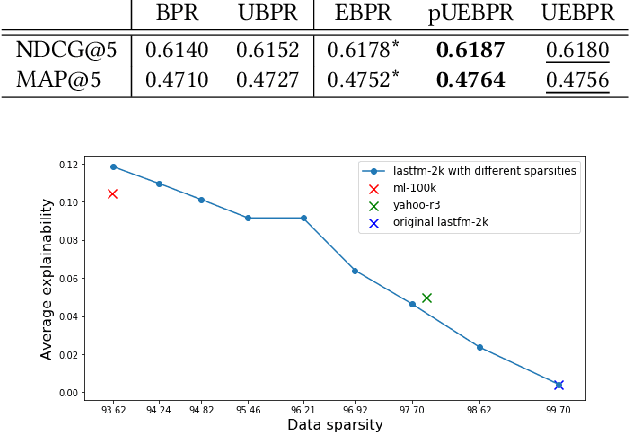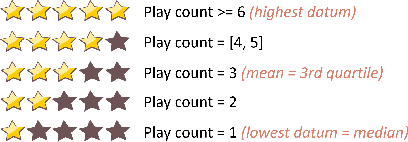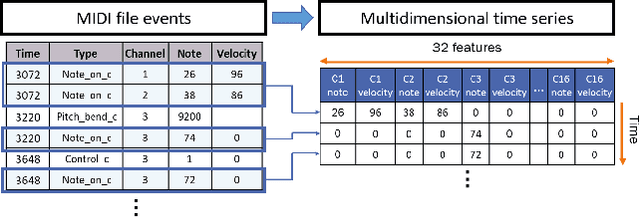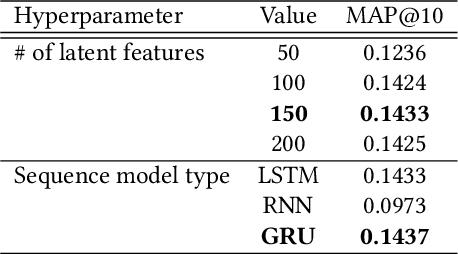Khalil Damak
Debiasing the Cloze Task in Sequential Recommendation with Bidirectional Transformers
Jan 22, 2023Abstract:Bidirectional Transformer architectures are state-of-the-art sequential recommendation models that use a bi-directional representation capacity based on the Cloze task, a.k.a. Masked Language Modeling. The latter aims to predict randomly masked items within the sequence. Because they assume that the true interacted item is the most relevant one, an exposure bias results, where non-interacted items with low exposure propensities are assumed to be irrelevant. The most common approach to mitigating exposure bias in recommendation has been Inverse Propensity Scoring (IPS), which consists of down-weighting the interacted predictions in the loss function in proportion to their propensities of exposure, yielding a theoretically unbiased learning. In this work, we argue and prove that IPS does not extend to sequential recommendation because it fails to account for the temporal nature of the problem. We then propose a novel propensity scoring mechanism, which can theoretically debias the Cloze task in sequential recommendation. Finally we empirically demonstrate the debiasing capabilities of our proposed approach and its robustness to the severity of exposure bias.
* 10 pages, 3 figures, Accepted at KDD '22
Debiased Explainable Pairwise Ranking from Implicit Feedback
Jul 30, 2021



Abstract:Recent work in recommender systems has emphasized the importance of fairness, with a particular interest in bias and transparency, in addition to predictive accuracy. In this paper, we focus on the state of the art pairwise ranking model, Bayesian Personalized Ranking (BPR), which has previously been found to outperform pointwise models in predictive accuracy, while also being able to handle implicit feedback. Specifically, we address two limitations of BPR: (1) BPR is a black box model that does not explain its outputs, thus limiting the user's trust in the recommendations, and the analyst's ability to scrutinize a model's outputs; and (2) BPR is vulnerable to exposure bias due to the data being Missing Not At Random (MNAR). This exposure bias usually translates into an unfairness against the least popular items because they risk being under-exposed by the recommender system. In this work, we first propose a novel explainable loss function and a corresponding Matrix Factorization-based model called Explainable Bayesian Personalized Ranking (EBPR) that generates recommendations along with item-based explanations. Then, we theoretically quantify additional exposure bias resulting from the explainability, and use it as a basis to propose an unbiased estimator for the ideal EBPR loss. The result is a ranking model that aptly captures both debiased and explainable user preferences. Finally, we perform an empirical study on three real-world datasets that demonstrate the advantages of our proposed models.
* 11 pages, 2 figures, Accepted at RecSys '21
SeER: An Explainable Deep Learning MIDI-based Hybrid Song Recommender System
Jun 25, 2019



Abstract:State of the art music recommender systems mainly rely on either Matrix factorization-based collaborative filtering approaches or deep learning architectures. Deep learning models usually use metadata for content-based filtering or predict the next user interaction by learning from temporal sequences of user actions. Despite advances in deep learning for song recommendation, none has taken advantage of the sequential nature of songs by learning sequence models that are based on content. Aside from the importance of prediction accuracy, other significant aspects are important, such as explainability and solving the cold start problem. In this work, we propose a hybrid deep learning structure, called "SeER", that uses collaborative filtering (CF) and deep learning sequence models on the MIDI content of songs for recommendation in order to provide more accurate personalized recommendations; solve the item cold start problem; and generate a relevant explanation for a song recommendation. Our evaluation experiments show promising results compared to state of the art baseline and hybrid song recommender systems in terms of ranking evaluation.
 Add to Chrome
Add to Chrome Add to Firefox
Add to Firefox Add to Edge
Add to Edge